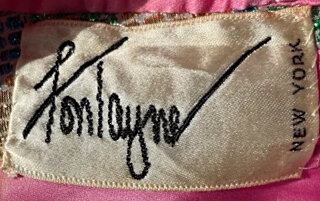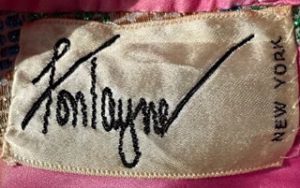Fontayne was an American fashion model turned designer. Her real name was Audrey Harriet Fountaine Goldsmith. She was born February 21, 1927.
Often when modeling, she would show up in one of her own creations and other models would swoon over her dress so she went into business. She opened her own shop in 1954 even though she flunked sewing in high school because she sewed too fast, and the graduation dress she made for herself at the time was so avant-garde that it was “suspect”. She grew up in Long Island, NY and had been making her own clothes since the age of 10, her dolls were “the best-dressed in the neighborhood”. When she was 12, she designed Easter hats and sold dozens. She had no formal training, used no patterns and no muslin, but “attacked the fabric with scissors and took it on from there”. She sold her car for cash to buy fabrics for her first collection, and within four months, a movie newsreel company voted her one of the top five designers in the US, taking some of her designs to Vienna as America’s answer to French couture. She designed for Hollywood stars like Janet Leigh, Carol Burnett, Polly Bergen, Hope Hampton, Florence Henderson, and Hildegarde.
Fontayne modeled her own designs whenever her collections were shown, frequently at large hotels in New York. She married her first husband, the famous Ballet Theater dancer Jack Beaber in 1952. In 1957, she made the news for turning to menswear “not professionally” designing garments for her husband who had just been in “Fanny” on Broadway. She made him sports shirts and coats with natural shoulder lines and much shorter jackets than were popular at the time. In 1959, a top NY designers’ fashion show with over 250 fashion editors in attendance, proclaimed that while the show highlighted many of the great names of American couture, young designer Fontayne’s fashion ideas were “prophetic”. She stole the show with a wedding gown made of multiple yards of sheer white wool. Each of her collections starred at least one cape, a sort of a fashion signature. She created custom clothes for ready-made clothes prices, occasionally designing for theater and television. She was the costume designer of The Doctor and the Playgirl (1963).
At a 1960 jewelry show, her lemon chiffon evening gown was the background for the $500,000 Tiffany Diamond mounted in a bib necklace and accessorized with buds of diamond leaves. The same year, she designed the ball gowns for former Miss America title holders as well as the 1961 coronation cape.
She stated that she designed “for the woman who is old enough to know what it’s all about and young enough to enjoy it”. All her clothes were one-of-a-kind and she never allowed her designs to be mass produced. Her designs were timeless and ignored trends. She was friends with many of her clients and viewed herself as their confidante. Her East side salon had an ambiance that allowed many clients to “act out their fantasies and that freedom was worth any price”. An avid dancer, she was particularly fond of clothes that moved. A choreographer once commented that “her gowns look like she’s dancing even when she’s standing still.”
She was divorced twice and once engaged to actor Chuck Connors. When not designing, she was also an interior designer. In a 1977 article, she billed herself as “New York’s last truly exclusive couturier” and modeled her designs for charity into the ’80s. She died November 13, 2006.
Written by Vintagiality



